When you visit the App Store or Google Play and search "social media," there are hundreds of apps to choose from. But, as the pool of social platforms grows, will any of them really change the game for marketers this year?
The truth is, probably so. The year 2020 changed the way we did just about everything — including socializing. Social distancing became a familiar part of our lives leaving a void for personalized communication we used to have in-person.
Nevertheless, humans are adaptable, and several new social networking sites have emerged in the last twelve months to recreate the communities we've had to abandon abruptly.

2021 Social Media Trends
The hottest trend thus far is audio-based social networking. Stephanie Morgan, social media expert and founder of marketing agency Social Lock sees a bright future for this new type of community, “Audio-based social networking is a relatively new concept, but it isn’t going anywhere anytime soon.”
Aside from Facebook and Snapchat, we've also been watching platforms like Reddit and Pinterest aim to improve on advertising and marketing features.
But, if your role specializes in social media, audience growth, or online engagement — or if your company targets the early-adopters in Gen-Z or millennial age groups — you'll still want to be on the lookout for platforms that could gain momentum later on.
Why? Watching the growth of young, promising social channels will help you determine which are worth joining and which aren't worth your time. And, if you do end up joining a hot new social channel early on, you may have more time to pick up on what promotional content works there. This will put you ahead of competitors that launch their accounts later and might struggle to come up with creative post ideas.
To help you stay on the cutting edge of social media, we've compiled a list of six young social platforms that you might want to put on your radar this year. These platforms have all gained a large user base, interest from investors, or news buzz in recent months.
For each platform, we'll walk you through how it works, its user base, why it might be promising to marketers later on, and how you should approach it today.
1. TikTok
Year Launched: 2017 (Founded in 2016)
Number of Users: 1 billion monthly active users
In 2018, the lip-syncing app, Musical.ly merged with a similar one-year-old app called TikTok. Since then, TikTok has reportedly reached 1 billion active monthly users. With more than 2.6 billion global downloads, TikTok is now more popular in app stores than Facebook, Instagram, and other prominent social media platforms.
For those who remember Vine or Musical.ly, TikTok is like a mix of the two. The platform allows you to film short videos that play on a repetitive loop just like Vine. But, like Musical.ly or Snapchat, you can add fun effects, AR filters, text, and musical overlays to zest things up. Like similar video platforms, it has been primarily adopted by users under 30 years old.
Once you make a video, the app also allows you to optimize it by adding hashtags that can make it easier to find via search.
One way hashtags have been embraced on TikTok is through its "Challenges" tab. This area of the platform prompts you to propose a challenge with a themed hashtag. When you post a video that responds to a challenge, you can include the corresponding hashtag so those following the challenge can see your videos.
Along with being widely discussed by publications including the New York Times and Digiday, the app has also gained notoriety from comedians like Jimmy Fallon. Here's a clip from The Tonight Show where he talks about the app and tells fans to compete in his #tumbleweed challenge:
Aside from being fun and entertaining, the app is "leaking into brand territory," according to Krystal Wu, HubSpot's Social Media Community Manager. She explained that more brands are on the platform, adding that, "The Washington Post is on TikTok and they are pretty popular too."
The Washington Post, as she mentioned, has already gained nearly 850,000 followers.
While you would expect a newspaper like this to post content with a more serious or investigative tone, the Post shows off a lighter, behind-the-scenes look at its newsroom. In this example, one of its journalists struggles to walk up the stairs to the sounds of MGMT's "Electric Feel":
Brands like Guess have also started to experiment with TikTok. To highlight its new line of denim clothing, Guess launched the #inMyDenim challenge encouraging users to publish videos of themselves wearing Guess denim with Bebe Rexha's song, "I'm a Mess." playing in the background.
Here's a video that someone posted in response to the challenge:
Brands like Guess have also started to experiment with TikTok. To highlight its new line of denim clothing, Guess launched the #inMyDenim challenge encouraging users to publish videos of themselves wearing Guess denim with Bebe Rexha's song, "I'm a Mess." playing in the background.
Here's a video that someone posted in response to the challenge:
At the moment, fashion, publishing, and entertainment companies are starting to play with TikTok. As the platform grows, we might see it expand to other industries that are able to get creative and visual with their marketing tactics.
While you might not want to focus all of your social media resources on TikTok just yet, it's a great time to familiarize yourself with the app and start experimenting with a few fun videos. You could also try to brainstorm a few challenges or video ideas that could align well with your brand and the platform's young audience. If you see any brands that are in a similar space as you, follow them for some added inspiration.
2. Clubhouse
Year Launched: 2020
Number of Users: Unspecified
Unlike traditional social media sites Facebook or Twitter which provide an asynchronous platform for communicating and sharing content, Clubhouse leverages synchronous, audio-only connectivity between the audience and the speakers. It’s not quite a podcast, but a more personal way to share information with your audience who can talk back to you in real-time. You might be wondering “What actually happens in Clubhouse?” And the truth is, a little bit of everything. Topics like starting a business from top VCs, relationship discussions hosted by celebrities, and even comedy clubs by up-and-coming comedians all find their way in front of live audiences.
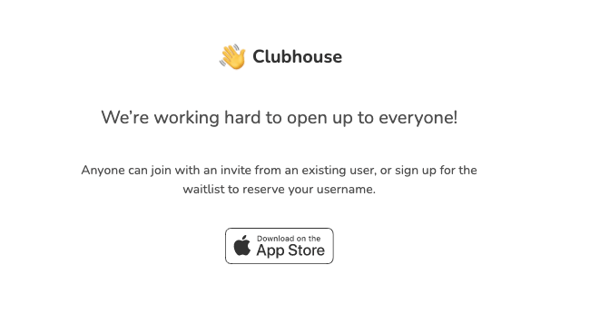
Before we talk about how much of a stir Clubhouse has caused in the tech space, we have to tell you that the app is only available in beta on devices that support iOS. That hasn’t been a hindrance to the platform thus far; Investors are lining up to support the development and expansion of the audio-only phenomenon, even without a presence on Google Play Store.
Part of the sudden uproar about this new social media network stems from the way it contradicts every other social platform available today. It’s invite-only — the antithesis of how we’ve come to understand and leverage social media. The developers of the app say they want to get Clubhouse just right before releasing it to the public, but users already part of the in-group act as the gatekeepers to thousands of conversations happening daily. If you don’t know someone willing to give you one of their three invitations, you’ll have to join the waitlist until Clubhouse is officially released.
How can Clubhouse work for marketers and brands? That’s yet to be determined, but professionals are experimenting right now. The race to crack the code on Clubhouse is a fast one as content creators are building their audiences quickly in hopes of securing monetization opportunities when they become available.
If you’ve received an invitation to Clubhouse, but aren’t sure how to use it, consider hosting an informal focus group, starting a conversation about a high-traffic blog article or social media post your company has published, or contributing to a conversation already hosted by a thought leader in your industry.
3. Twitter Spaces
Year Launched: 2020
Number of Users: Unspecified
You may not have heard of this one yet (it was just released in December 2020), but it’s picking up steam fairly quickly. Similar to Clubhouse, Twitter Spaces is a beta version of the app’s newest audio feature. This voice chat alternative to the social platform’s traditional 280 character tweets is open to anyone with an iOS device, but only a select group of people chosen by Twitter can create their own space to start a conversation.
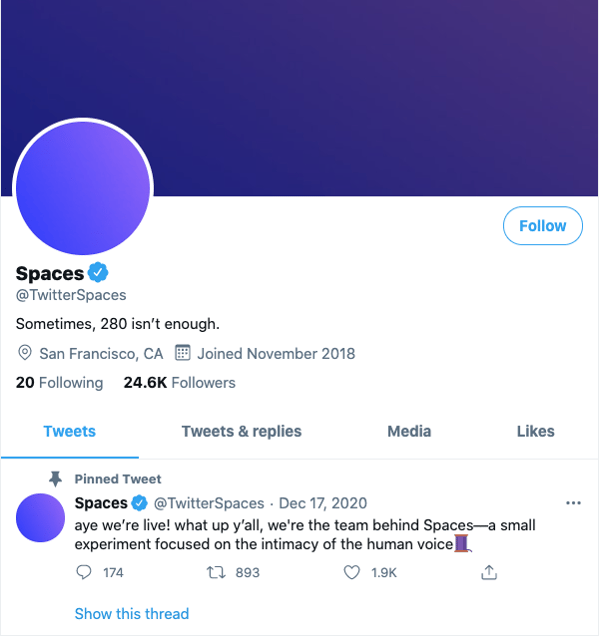
While the app is similar in nature to Clubhouse, Twitter is venturing into this new audio-only territory to discover opportunities and threats in this type of community. Clubhouse has addressed its challenges with enforcing community standards – an opportunity Twitter wants to figure out to make the platform safe for everyone.
Stephanie Morgan, social media manager at Social Lock, predicts some promising insights about the newest audio-only social network by Twitter, “Spaces will be a great feature on Twitter because it’s already a dialogue friendly, majority non-visual platform.” She anticipates that hosting live discussions, training sessions, and customer Q&As could be a few use cases for businesses to utilize Twitter Spaces once it is released to the public.
Although this social tool probably won’t be a good fit for you or your business anytime soon, it is fascinating to watch in real-time. Even if you can’t use Twitter Spaces, perhaps you’ll be inspired by the team’s human-centered approach to developing the feature.
4. Caffeine
Year Launched: Founded in 2016 and unveiled in 2018
Number of Users: Unspecified
Caffeine.tv, a platform built by ex-Apple designers, allows you to create live broadcasts for friends and followers. The broadcasts show up in a feed where you can give an emoji reaction or respond with comments.
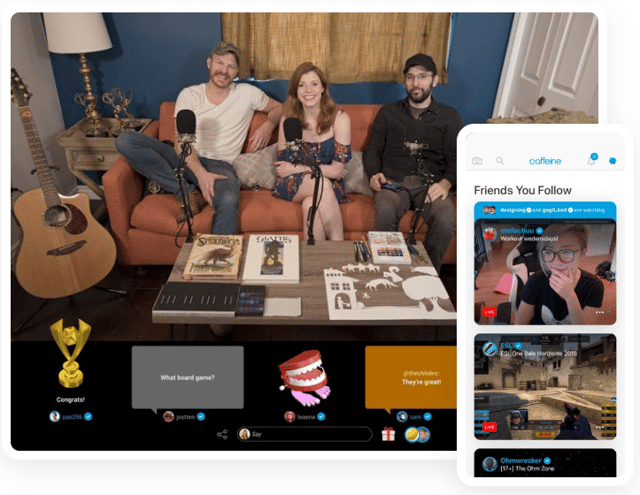
Along with live video broadcasts, you can also stream your computer or TV screens as you play video games. This makes Caffeine a possible competitor to the slightly older game-streaming service, Twitch.tv. Like Twitch, which offers you money for high views or subscriptions, Caffeine has launched a monetization program that rewards engaging broadcasters.
The company hasn't specified user numbers yet, but its Crunchbase profile reveals that it has over $259 million in investments so far. Caffeine's biggest investor to date is 21st Century Fox.
Aside from investor interest, the platform is starting to make waves in the worlds of entertainment and sports. Recently, the platform was used to broadcast the 2019 X Games in Aspen.
Caffeine's success so far demonstrates how live video and video platforms are gaining quick adoption from younger audiences, especially in the Gen-Z age group. If the app continues to gain interest, marketers might consider using it to show off their brand through a variety of strategies, like behind-the-scenes content, Q&As, or other live videos. This platform could also be useful to marketers in a wide variety of industries, including news, entertainment, gaming, and sports.
If live streaming could help your company spread awareness of a product, it might be a good time to familiarize yourself with both Caffeine and Twitch. As you learn more about the platforms, be sure to determine if your audience is actually using either of them and what they're using them for. Similarly to TikTok, you should also check out what similar brands are doing if you find any with active accounts.
If you have an idea for a live stream that seems too out of the ordinary for Facebook or Instagram, Caffeine could be an interesting place to test it. Because the platform is new, there might not be many norms or rules associated with what content works or doesn't work just yet.
5. Instagram Reels
Year Launched: 2020
Number of Users: Unspecified
We can’t deny that TikTok changed the game for social media since its debut in 2017. It’s still on our list this year as the platform continues to reinvent itself and expand into new audiences. Last year Facebook took notice of the TikTok trend and responded with Lasso, but ended the effort to make room for Instagram Reels.
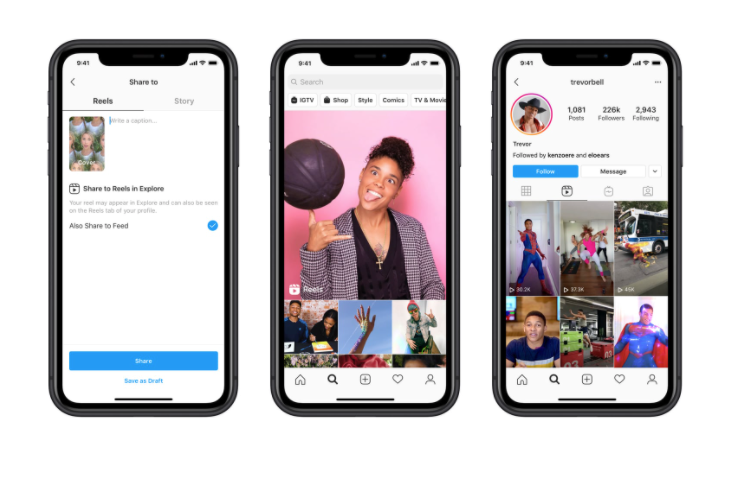
Reels is now in direct competition with TikTok, offering a similar video creation functionality. Instagram users can create videos adorned with special effects, music, and transitions notorious for keeping users in a loop.
How can reels work for your business? Everything from sharing product releases to how-to guides, Reels can be an engaging method for brands to make a presence with the Gen Z audience. If you’re not sure how to start, The Social Impact has some fun and informative examples of how to use Reels.
Not sure how to leverage this new Instagram feature? Start with your brand. Reels are a fun type of content that can display your brand’s personality. You don’t need fancy camera equipment or a director to publish content that has the viral factor. If your team simply doesn’t have the capacity to produce this content yet, consider tapping an industry influencer to create reels on your behalf.
6. Houseparty
Year Launched: 2016
Number of Users: 20 million+
Houseparty is a group-video messaging app that allows video chats that can host eight users at a time. To make things more fun for everyone in the chat, you can use video filters, stickers and other fun effects while a live conversation is in session.
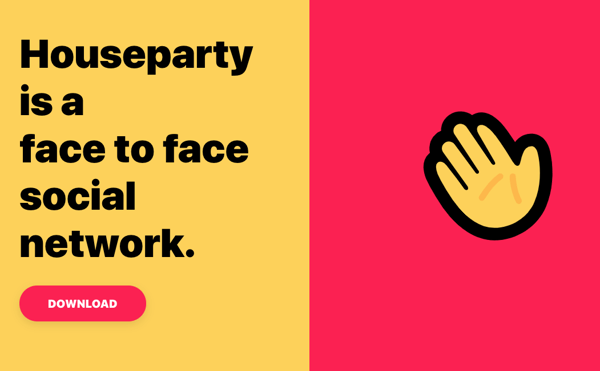
While the app itself has been around for a few years, it has gone through a few evolutions and recently gained large bumps in interest and users. The app first started as Meerkat, but rebranded itself to Houseparty and revamped its features. Since then, Houseparty has climbed app store charts and risen from 1 million to 50 million users in 2020.
Although the app does offer ad space, marketers of the future might use it in other creative ways. For example, a small makeup company might sponsor a "houseparty" where an influencer can answer beauty questions and show attendees how to use one of their new beauty products.
Although it might sound promising, still keep in mind that this app has a number of big-name competitors, including Snapchat and Zoom..
This app might also take added time and creativity. If you don't have time to host a houseparty or can't think of one that would effectively market your product, you might want to prioritize other platforms first.
How to Navigate The New Social Media Landscape
A marketer who discovers a hot new social channel first can become an expert on posting engaging content before their competitors even sign up. But, while it's important for marketers to keep interesting platforms on their radar, the first priority should still be to focus time, effort, and resources on the platforms that are already thriving.
To make sure you're balancing your time between new and old channels accordingly, focus on growing and refining strategies on the successful platforms, then timebox an hour or so once a month to look into newer platforms.
If you find a platform like TikTok, that's both relatively new and has a fast-growing user base, brainstorm, and schedule a few experimental posts.
Be sure to use experimentation time wisely and on the right platforms. While TikTok is a great place to experiment and doesn't seem like it's going anywhere soon, there's always a chance that an extremely niche platform, like Clubhouse, could get overshadowed by a larger competitor – Twitter Spaces.
When you're determining which platforms are worth watching or experimenting on, here are six questions your team should ask themselves:
- What are its active user numbers? Big numbers could mean that the platform is gaining momentum and that you have even more chances to engage with a large pool of users.
- Are publications or thought leaders talking about it? If a platform doesn't specify exact numbers, but a lot of people, prominent figures, or news publications are discussing it -- it might be promising.
- Do older platforms have a similar tool and a bigger user base? If an older platform does the same thing, people might hesitate to adopt a newer platform. For example, marketers primarily use Stories on Instagram as opposed to Snapchat. Although Snapchat pioneered the story, the Instagram interface and experience is something that a lot more people know, understand, and trust.
- Will my audiences understand how to use the platform? Will my audiences understand how to use the platform? It might be challenging to get a less tech-savvy person to join Snapchat or TikTok, but they might love a platform like Facebook or Twitter because the interfaces might be easier to understand. Pick platforms that your audience can easily use and enjoy.
- Will audiences even be interested in the platform? Will audiences even be interested in the platform? While a tech novice might not enjoy TikTok, a teenager might get bored on a platform like Facebook. In fact, younger people prefer visual apps like TikTok and Instagram. While you want to pay attention to the level of adaptability, you also should pay attention to how your audience wants to consume media.
- What type of content or post could we use to promote our brand on the platform? You should always make a plan of action when considering or launching a social platform. If you can't come up with any interesting ways to market your specific product on a niche platform, you might want to hold off on making an account. On the other hand, experimenting with different posting strategies could allow your brand to look creative and cool to the platform's audience.
Should you follow the social media trends of 2021?
Consumer behavior changes quickly in the digital space, and businesses that adapt to social media trends could see success. If you keep an eye on this kind of marketing research and tailor it to your target audience, you can craft a stellar social media plan that drives awareness and shows your brand in a creative light.
Remember, every trend won’t work to achieve your goals, so don’t venture into this new social media landscape without the most up to date data. We’ve done the heavy lifting for you in the 2020 Marketing Trends research report. The data inside is sourced from more of the experts you’ve heard from in this article and will help you introduce the next big moment on your social media platforms.
Editor's note: This post was originally published in July 2019 and has been updated for comprehensiveness.
from Marketing https://ift.tt/2JVNChz
via

No comments:
Post a Comment